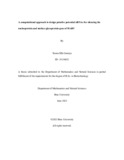| dc.contributor.advisor | Sayem, Mohammad | |
| dc.contributor.author | Suraiya, Tasnia Iffat | |
| dc.date.accessioned | 2023-12-12T06:25:07Z | |
| dc.date.available | 2023-12-12T06:25:07Z | |
| dc.date.copyright | 2023 | |
| dc.date.issued | 2023-06 | |
| dc.identifier.other | ID 18136032 | |
| dc.identifier.uri | http://hdl.handle.net/10361/21967 | |
| dc.description | This thesis is submitted in partial fulfillment of the requirements for the degree of Bachelor of Science in Biotechnology 2023. | en_US |
| dc.description | Catalogued from PDF version of thesis. | |
| dc.description | Includes bibliographical references (pages 37-43). | |
| dc.description.abstract | Marburg virus (MARV), a member of the Filoviridae family, is the causal agent of a highly fatal hemorrhagic fever with mortality rates ranging from 23% to 90% in humans. This virus is endemic to central Africa and leads to sporadic outbreaks from time to time with a significant death toll. Despite the severity of the disease caused by filoviruses, no licensed vaccine or therapeutic is available. MARV contains a nonsegmented, negative-sense, single-stranded RNA genome composed of seven genes of which the surface glycoprotein mediates entry into host cells and the nucleoprotein is essential for genome replication. The indispensable roles of these genes in the viral life cycle make them suitable targets for designing therapeutics.
Small interfering RNA (siRNA) is a promising option of antiviral therapy utilizing the RNA interference (RNAi) pathway by suppressing viral gene expression through hybridization and neutralization of complementary target mRNA. In this study, we aim to harness the power of RNA interference technology to develop siRNA molecules against specific target genes of MARV. | en_US |
| dc.description.statementofresponsibility | Tasnia Iffat Suraiya | |
| dc.format.extent | 43 pages | |
| dc.language.iso | en | en_US |
| dc.publisher | Brac University | en_US |
| dc.rights | Brac University theses are protected by copyright. They may be viewed from this source for any purpose, but reproduction or distribution in any format is prohibited without written permission. | |
| dc.subject | MARV | en_US |
| dc.subject | siRNA design | en_US |
| dc.subject | Bioinformatics | en_US |
| dc.subject.lcsh | Marburg virus disease | |
| dc.subject.lcsh | Small interfering RNA | |
| dc.title | A computational approach to design putative potential siRNAs for silencing the nucleoprotein and surface glycoprotein gene of MARV | en_US |
| dc.type | Thesis | en_US |
| dc.contributor.department | Department of Mathematics and Natural Sciences, Brac University | |
| dc.description.degree | B. Biotechnology | |

